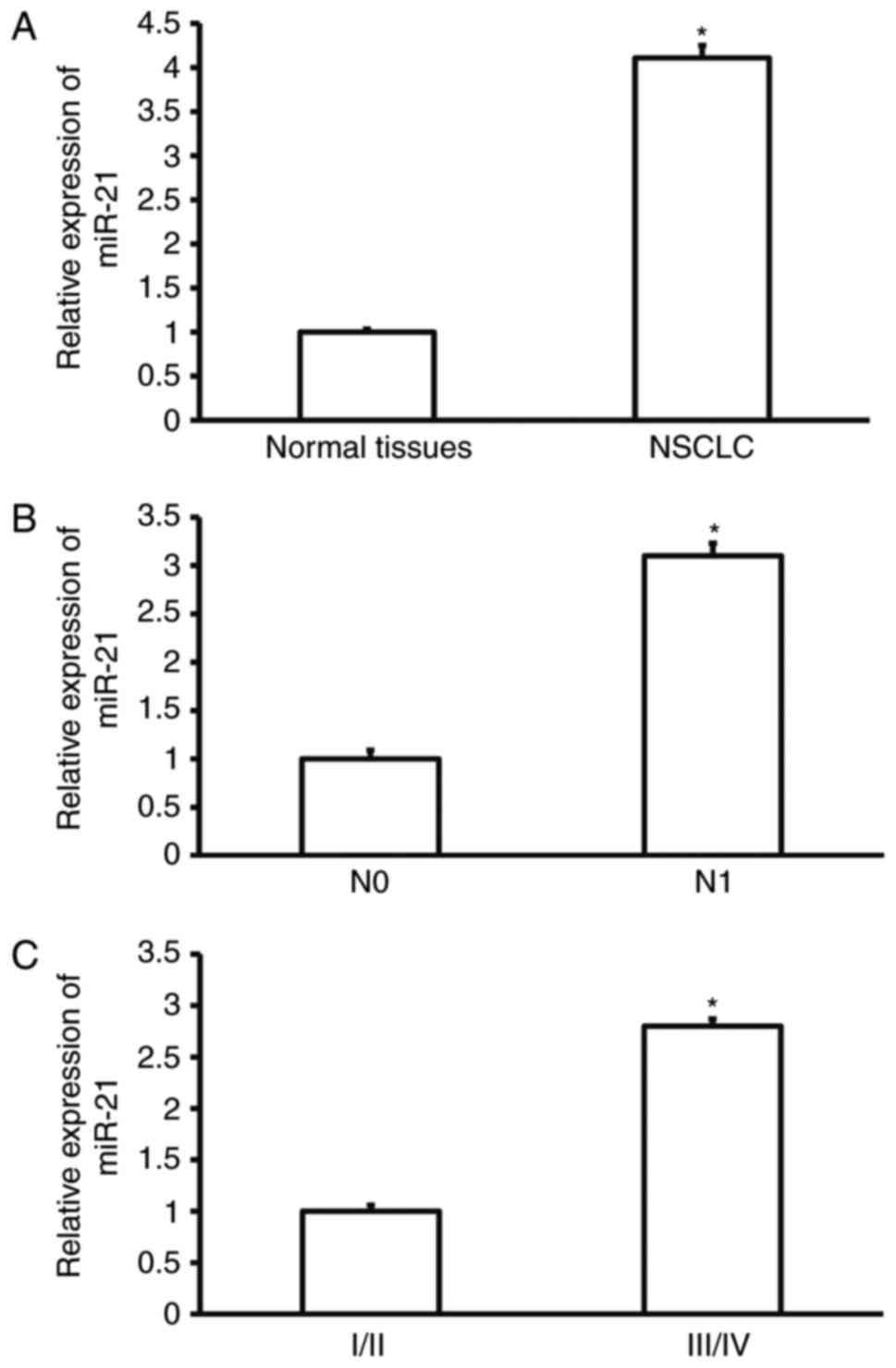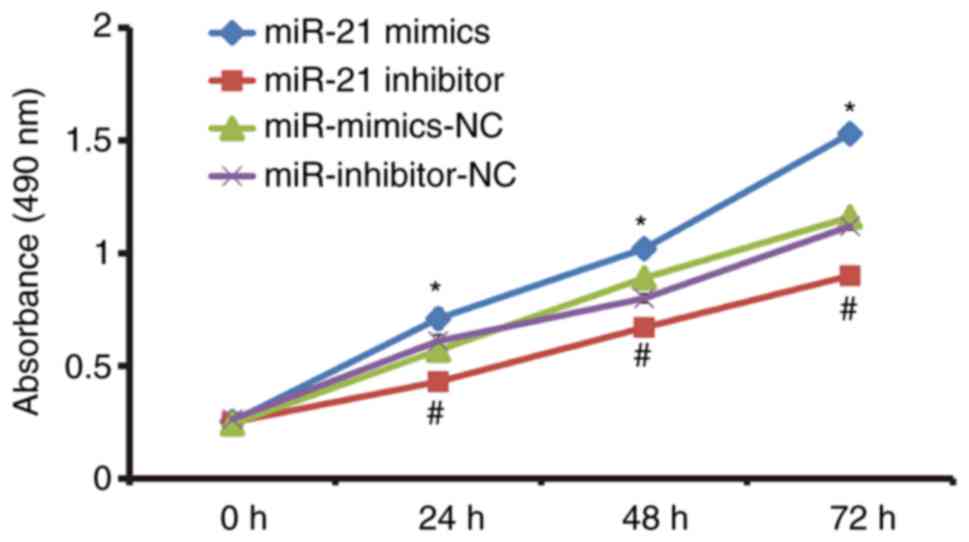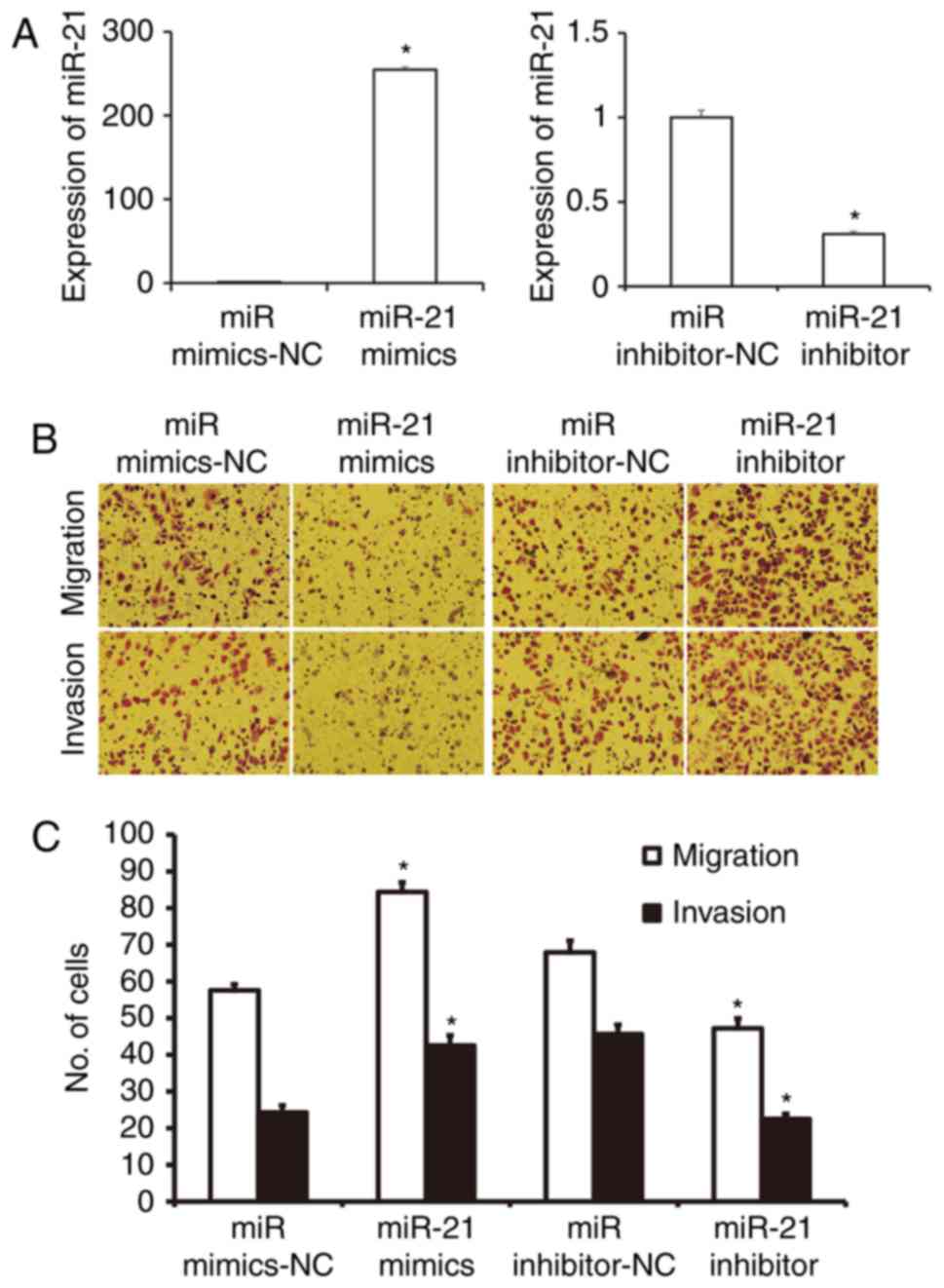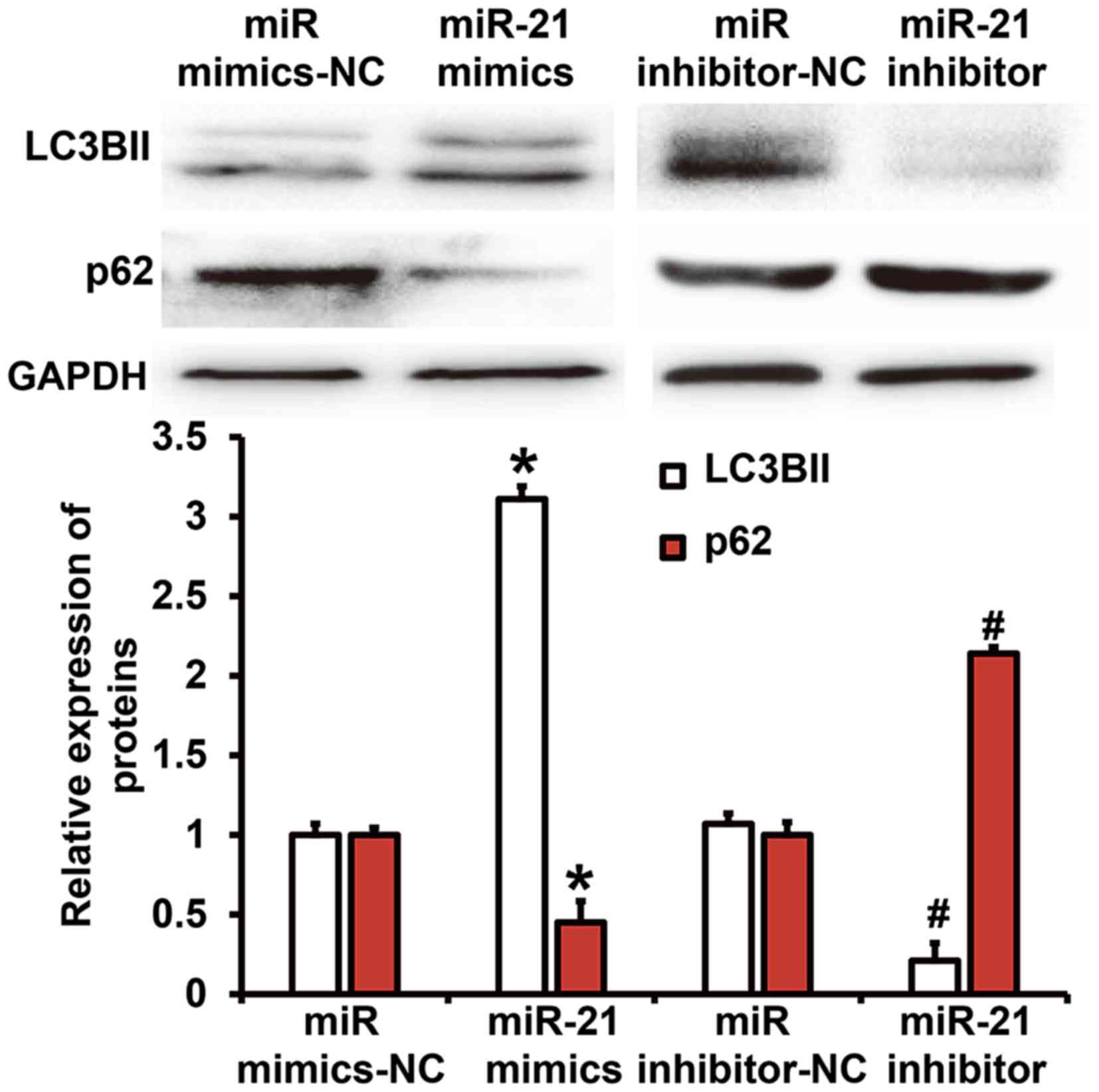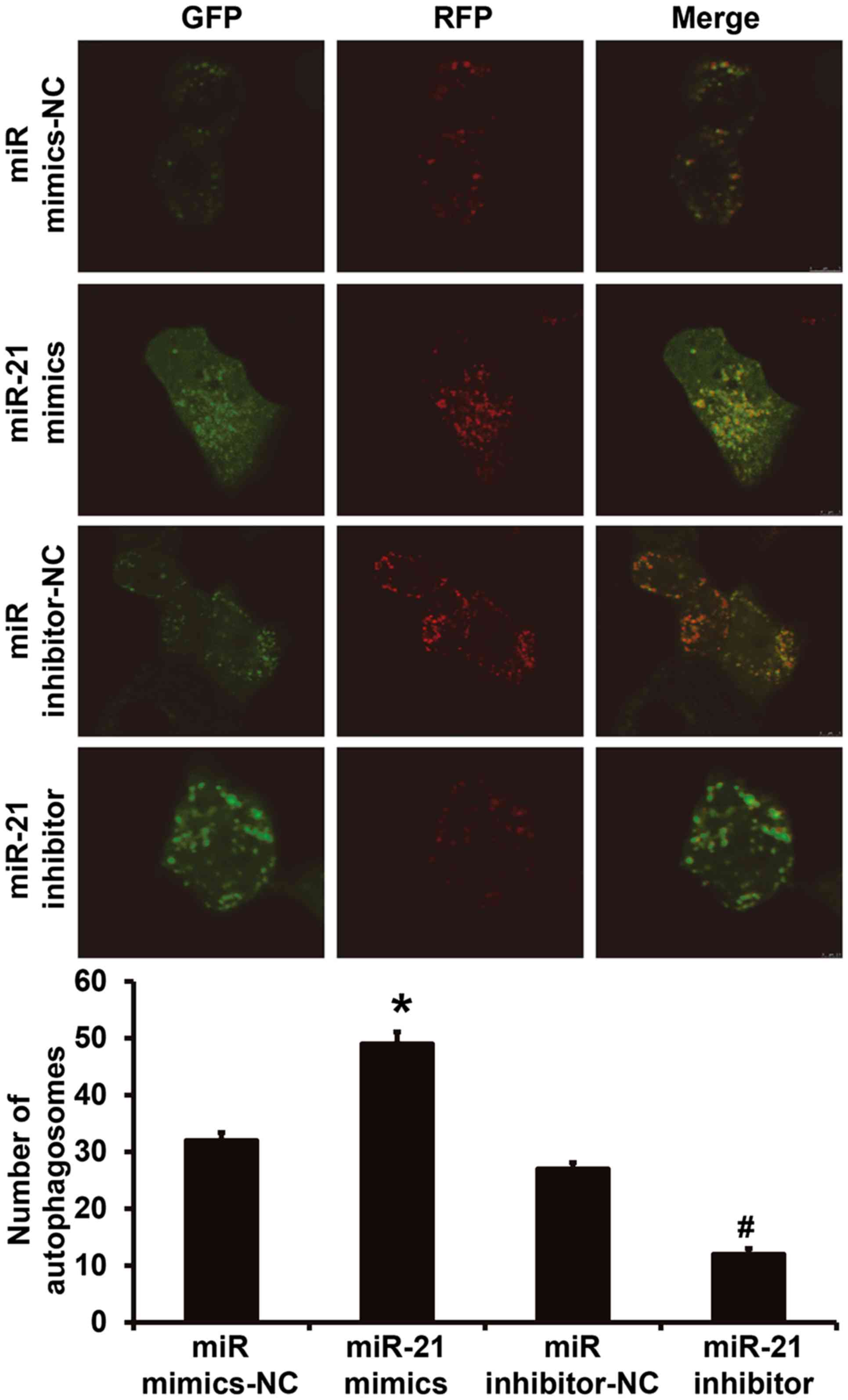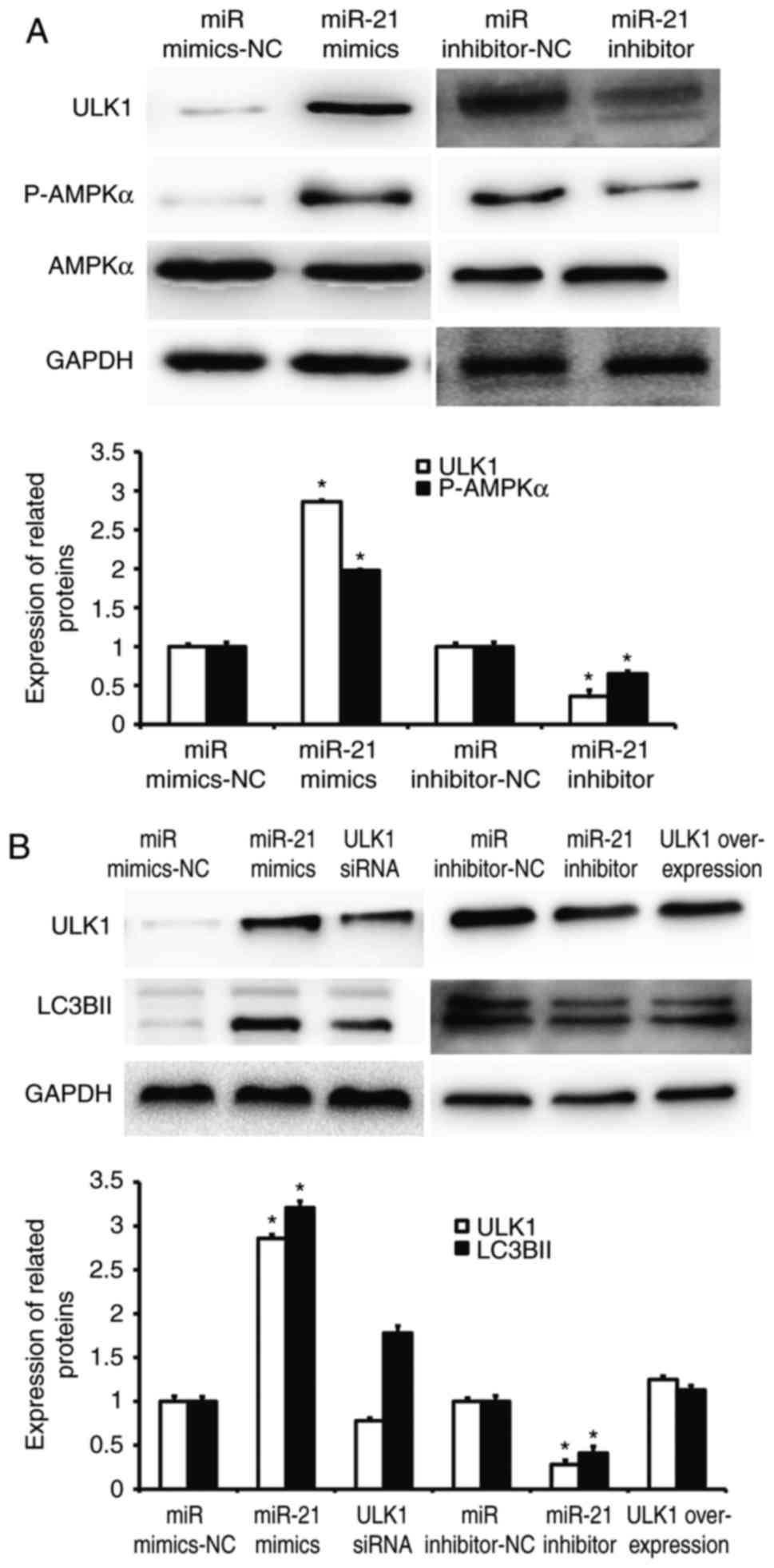Introduction
Lung cancer is one of the most common malignant
tumors in the world (1). It is
usually derived from bronchial tip membranes or glands, and
accompanied by regional lymph node metastasis or hematogenous
dissemination (2). Approximately 1.8
million new cases of lung cancer are reported worldwide each year,
accounting for 12.9% of all new cancer cases (3). Of note, the incidence of lung cancer in
men is higher than that in women. One third of new and fatal cases
of lung cancer occur in China, posing a great threat to human
health (4). Most lung cancer cases
are malignant epithelial tumors, including non-small cell lung
cancer (NSCLC; 85%) and small cell lung cancer (15%) (5). The clinical symptoms of NSCLC are
occult, and most patients have already got metastasis when they are
diagnosed. Moreover, patients with successful surgery often develop
tumor resistance, leading to chemoradiotherapy failure, tumor
recurrence or even death (6). It is
believed that effective inhibition of lung cancer proliferation,
metastasis and drug resistance will greatly improve the prognosis
of patients. However, the molecular mechanisms underlying the
malignant phenotype of lung cancer cells still remain unclear.
MicroRNA (miRNA or miR) molecules is a class of
non-encoding small RNA molecules (18–22 nucleotides) that inhibit
the translation of target genes by binding with the 3′-untranslated
region (UTR) of their mRNA (7).
miRNA molecules play a role as oncogenes or tumor-suppressor genes
in tumor proliferation, metastasis and drug resistance, being a
type of important biomarkers and therapeutic targets (8,9). It is
discovered that the expression of several miRNA molecules is
abnormal in lung cancer, and closely related with the occurrence
and development of NSCLC (6). For
example, miR-30a-5p inhibits the resistance of NSCLC against
paclitaxel by down-regulating the expression of Bcl-2 (10). In addition, miR-361-5p inhibits the
proliferation and metastasis of NSCLC by targeting FOXM1 (11). miR-21 is a newly discovered miRNA
molecule that is closely related with tumors (12). It is reported that miR-21 plays a
role as an oncogene in NSCLC, and promotes the proliferation,
invasion, metastasis and drug resistance of NSCLC (13,14).
However, the mechanism of action of miR-21 is still unknown.
Autophagy is a catabolic process in which cells are
subjected to stress such as hypoxia, starvation, and lack of
nutrients (15). Autophagy acts as a
‘double-edged sword’ in tumorigenesis and development (16,17). On
one hand, autophagy inhibits the occurrence and development of
tumors by degrading abnormal components in cells or inducing
non-apoptotic pathway death. On the other hand, tumor cells promote
proliferation, invasion and metastasis through autophagy. Autophagy
inhibitor chloroquine can greatly promote the death of tumor cells
when used in combination with chemotherapy drugs (18). Studies show that miRNA molecules such
as miR-181a and miR-140-5p are important in autophagy regulation
(19,20). It is reported that miR-21 is able to
regulate the drug resistance of NSCLC (21). Therefore, it is hypothesized that
miR-21 may participate in the occurrence and development of NSCLC
by regulating autophagy. In the present study, we investigate the
molecular mechanism by which miR-21 regulates autophagy, and try to
elucidate the role of miR-21 in the development of NSCLC.
Materials and methods
Patients
A total of 46 patients with NSCLC (age range, 24–76
years; mean age, 46.7 years) who received treatments at our
hospital between October 2014 and 2016 were included in the present
study. NSCLC and tumor-adjacent tissues were collected as
experimental and control groups, respectively. The 46 NSCLC cases
included 31 cases of adenocarcinoma, 13 cases of squamous cell
carcinoma, and 2 cases of adenosquamous carcinoma. Patients with
lymph node metastasis (29 cases) were included into N1 subgroup,
while those without lymph node metastasis (18 cases) were included
into N0 subgroup. In addition, 11 patients were at stage I, 17
patients were at stage II, 13 patients were at stage III, and 6
patients were at stage IV. None of the patients received
radiochemotherapy or other antineoplastic therapies. None of the
patients had history of other types of tumors. All procedures were
approved by the Ethics Committee of Chengdu Medical College.
Written informed consents were obtained from all patients or their
families.
Cells
NSCLC A549 cells were cultured in RPMI-1640 medium
supplemented with 10% fetal bovine serum (FBS) under 37°C and 5%
CO2. When reaching 80–90% confluency, the cells were
passaged. The medium was replaced every two days. Cells with
passage numbers 3–6 were used for experiments.
A549 cells were divided into miR mimics-negative
control (NC) group, miR-21 mimics group, miR inhibitor-NC group,
and miR-21 inhibitor group. On the day before transfection, the
cells (2×105) in log-phase growth were seeded onto
24-well plates containing antibiotics-free RPMI-1640 medium
supplemented with 10% FBS. When reaching 70% confluency, 1.5 µl miR
mimics-NC (random double-stranded RNA molecule; Hanbio
Biotechnology Co., Ltd., Shanghai, China), miR-21 mimics, miR
inhibitor-NC (random single-stranded RNA molecule; Hanbio
Biotechnology Co., Ltd.) or miR-21 inhibitor (20 pmol/µl; Guangzhou
RiboBio Co., Ltd., Guangzhou, China) and 1 µl Lipofectamine 2000
(Thermo Fisher Scientific Inc., Waltham, MA, USA) were added into
two individual vials containing 50 µl Opti Memi medium,
respectively. Five min later, the liquids in the two vials were
mixed together before standing still for another 20 min. Then, the
mixture was added onto the cells for an incubation of 6 h before
changing to RPMI-1640 medium supplemented with 10% FBS. The cells
were cultured at 37°C and 5% CO2 for 48 h before
use.
Rescue experiments were performed in two ways.
First, A549 cells (2×105) in miR-21 mimics and miR-21
inhibitor groups were seeded into 24-well plates containing
antibiotics-free RPMI-1640 medium supplemented with 10% FBS. When
reaching 70% confluency, the medium was replaced with the same
medium containing 25 µM 3-MA and 100 nM rapamycin and cultured at
37°C and 5% CO2 for 24 h before rescue experiments.
Second, A549 cells (2×105) in miR-21 mimics and miR-21
inhibitor groups were seeded into 24-well plates containing
antibiotics-free RPMI-1640 medium supplemented with 10% FBS. When
reaching 60% confluency, the cells were infected by 0.5 µg ULK1
eukaryotic expression plasmid (Hanbio Biotechnology Co., Ltd.) or
its siRNA sequence. Cells in miR-NC group were infected by 0.5 µg
NC plasmid. After being cultured at 37°C and under 5%
CO2 for 6 h, the medium was refreshed to newly made
RPMI-1640 medium containing 10% FBS before cultivation for 72 h.
Then, the cells in each group were used for subsequent
experiments.
Reverse transcription-quantitative
polymerase chain reaction (RT-qPCR)
NSCLC and tumor-adjacent tissues (100 mg) were
ground into powder using liquid nitrogen before addition of 1 ml
Trizol isolation reagent (Thermo Fisher Scientific, Inc.) for
lysis. After lysis, total RNA was extracted using phenol chloroform
method. The purity of RNA was determined by A260/A280 using
ultraviolet spectrophotometry (Nanodrop ND2000, Thermo Fisher
Scientific Inc.). Then, cDNA was obtained by reverse transcription
using miScript II RT kit (Qiagen GmbH, Hilden, Germany) from 1 µg
RNA and stored at −20°C.
RT-qPCR was performed using miScript SYBR-Green PCR
kit (Qiagen GmbH) and the reaction system was composed of 10 µl
RT-qPCR-mix, 0.5 µl upstream primer (5′-ACAGCAGGCACAGACAGGCAGT-3′),
0.5 µl downstream primer (universal primer provided by the kit), 2
µl cDNA and 7 µl ddH2O. Reaction protocol was initial
denaturation at 95°C for 10 min, and 40 cycles of 95°C for 1 min
and 60°C for 30 sec.
Cell Counting Kit (CCK)-8 assay
The sample cells were inoculated in 96-well plates
at a density of 2,000/well. At 0, 24, 48 and 72 h, 20 µl CCK-8 (5
g/l; Beyotime Institute of Biotechnology, Haimen, China) was added
onto the cells. After being incubated at 37°C for 2 h, absorbance
(490 nm) of each well was determined, and cell proliferation curves
were plotted. Each group was tested in 3 replicate wells and the
values were averaged.
Transwell assay
Matrigel chambers (Corning Incorporated, Corning,
NY, USA) were used to determine the migration and invasion
abilities of cells. Matrigel was first diluted with serum-free
RPMI-1640 medium at a ratio of 1:2. In upper chamber, 50 µl diluted
Matrigel was added and kept at 37°C for 1 h. Then, 1×105
cells and 200 µl serum-free RPMI-1640 medium were added into the
upper chamber. In the lower chamber, 500 µl RPMI-1640 medium
supplemented with 10% FBS was added. After incubation for 24 h, the
cells in upper chamber were wiped by cotton swab. Then, the chamber
was fixed using 4% formaldehyde for 10 min at room temperature, and
then subjected to Giemsa's staining for 1 min. After washing for 3
times, cells that moved to the other side of the chamber were
counted under a microscope (5 fields; magnification, ×200) to
evaluate migration and invasion abilities.
Laser confocal microscopy
Cells in each group were seeded onto culture plates
at a density of 2×105/well. When reaching 70%
confluency, Ad-GFP-RFP-LC3B was added at a ratio of MOI=20.
Seventy-two h later, the cells were observed under a laser confocal
microscope (SP8; Leica Microsystems GmbH, Wetzlar, Germany). Green
and red vesicles represented autophagy. The number of autophagy in
cells was counted to evaluate autophagy activity.
Western blot analysis
Cells in each group were trypsinized and collected.
Then, cold Radio-Immunoprecipitation Assay (RIPA) lysis buffer (600
µl; Beyotime Institute of Biotechnology) was mixed with the
samples. Then, the mixture was lysed for 30 min on ice, and then
centrifuged at 12,000 rpm and 4°C for 10 min. Bicinchoninic acid
(BCA) protein concentration determination kit (RTP7102; Real-Times
Biotechnology Co., Ltd., Beijing, China) was used to determine
protein concentration in the supernatant. After mixing protein
samples (6 µl) with 5× sodium dodecyl sulfate loading buffer, the
mixture was denatured by boiling in water bath for 10 min.
Afterwards, 10% sodium dodecyl sulfate-polyacrylamide gel
electrophoresis (100 V) was performed using the samples. Then, the
proteins were electro-transferred to polyvinylidene difluoride
(PVDF) membranes on ice (250 mA, 1 h) before being blocked with 50
g/l skimmed milk at room temperature for 1 h. Afterwards, rabbit
anti-human polyclonal ULK1 (1:1,000), LC3B (1:800), AMPKα
(1:1,000), p-AMPK (1:800) and p62 (1:800) primary antibodies and
mouse anti-human GAPDH (1:400) primary antibody (Abcam, Cambridge,
UK) were added onto the membranes before incubation at 4°C
overnight. Then, the membrane was extensively washed with
phosphate-buffered saline with Tween 20 (PBST) for 5 times of 5
min, and incubated with goat anti-mouse horseradish
peroxidase-conjugated secondary antibodies (1:4,000; Abcam) at room
temperature for 1 h. Subsequently, the membrane was washed with
PBST for 5 times of 5 min before the membrane was developed with
enhanced chemiluminescence detection kit (Sigma-Aldrich; Merck
KGaA, Darmstadt, Germany) for imaging. We used Image lab v3.0
software (Bio-Rad Laboratories, Inc., Hercules, CA, USA) to acquire
and analyze imaging data. The relative expression of target
proteins was expressed with the ratio against GAPDH.
Statistical analysis
All results were analyzed using SPSS v17.0
statistical software (IBM Corp., Armonk, NY, USA), and all data
were shown as means ± SD. Paired Student's t-test was used to
compare data between tumor-adjacent tissues and tumor tissues,
while unpaired Student's t-test was performed to compare intergroup
differences for lymph node metastasis and clinical staging.
Multigroup measurement data were analyzed using one-way ANOVA. In
case of homogeneity of variance, Least Significant Difference and
Student-Newman-Keuls methods were used; in case of heterogeneity of
variance, Tamhane's T2 or Dunnett's T3 method was used. P<0.05
was considered to indicate a statistically significant
difference.
Results
miR-21 expression in NSCLC tissues is
enhanced, and closely correlated with the occurrence and
development of NSCLC
To determine miR-21 expression in NSCLC tissues,
RT-qPCR was used. The data showed that miR-21 expression in NSCLC
tissues was significantly higher than that in tumor-adjacent
tissues (P<0.05; Fig. 1A). In
addition, miR-21 expression in NSCLC tissues from patients with
lymphatic metastasis was significantly higher than that in tissues
from patients without lymphatic metastasis (P<0.05; Fig. 1B). Moreover, miR-21 expression in
NSCLC tissues from patients at stages III/IV was significantly
increased than that from patients at stages I/II (P<0.05;
Fig. 1C). The result suggests that
miR-21 expression in NSCLC tissues is enhanced, and closely
correlated with the occurrence and development of NSCLC.
miR-21 expression promotes the
proliferation of NSCLC A549 cells in vitro
To test the proliferation of A549 cells, CCK-8 assay
was carried out. The data showed that absorbance of A549 cells that
were transfected with miR-21 mimics was significantly enhanced than
that in miR-NC group at all time points (P<0.05), while the
absorbance of A549 cells in miR-21 inhibitor group was
significantly decreased than that in miR-NC group at all time
points (P<0.05; Fig. 2). The
result indicates that miR-21 expression promotes the proliferation
of NSCLC A549 cells.
miR-21 expression enhances the
migration and invasion abilities of NSCLC A549 cells
To investigate migration and invasion abilities of
A549 cells, Transwell assay was employed. The data showed that the
expression of miR-21 in cells transfected with miR-21 mimics was
significantly higher than that in cells transfected with miR
mimics-NC (P<0.05), while expression of miR-21 in cells
transfected with miR-21 inhibitor was significantly lower than that
in cells transfected with miR inhibitor-NC (P<0.05; Fig. 3A). The number of cells in miR-21
mimics group that crossed chamber membrane in migration assay was
significantly higher than that in miR mimics-NC group (P<0.05).
By contrast, cell count in miR-21 inhibitor group that crossed
chamber membrane in migration assay was lower than that in miR
inhibitor-NC group (P<0.05). Similarly, cell count in miR-21
mimics group that crossed chamber membrane in invasion assay was
higher than that in miR mimics-NC group (P<0.05). In addition,
the number of cells in miR-21 inhibitor group that crossed chamber
membrane in invasion assay was smaller than that in miR
inhibitor-NC group (P<0.05; Fig. 3B
and C). The results suggest that miR-21 expression enhances the
migration and invasion abilities of NSCLC A549 cells.
miR-21 regulates autophagy activities
of NSCLC A549 cells
To test the expression of autophagy-related proteins
in A549 cells, western blotting was performed. Quantification of
western blots showed that LC3B-II protein expression in miR-21
mimics group was significantly higher than that in miR mimics-NC
group (P<0.05), while p62 protein expression in miR-21 mimics
group was significantly lower than that in miR mimics-NC group
(P<0.05). In addition, LC3B-II protein expression in miR-21
inhibitor group was significantly lower than that in miR
inhibitor-NC group (P<0.05), while p62 protein expression in
miR-21 inhibitor group was significantly higher than that in miR
inhibitor-NC group (P<0.05; Fig.
4). The result suggests that miR-21 regulates autophagy
activities of NSCLC A549 cells.
miR-21 expression facilitates the
autophagy of NSCLC A549 cells
To observe the formation of autophagosomes in A549
cells, laser confocal microscopy was performed. The data showed
that the number of autophagosomes in A549 cells of miR-21 mimics
group was significantly higher than that in miR mimics-NC group
(P<0.05), while that of miR-21 inhibitor group was significantly
lower than that in miR mimics-NC group (P<0.05; Fig. 5). The result indicates that miR-21
expression facilitates the autophagy of NSCLC A549 cells.
miR-21 promotes the proliferation,
migration and invasion of NSCLC A549 cells by regulating
autophagy
To test whether miR-21 regulates the biological
functions of A549 cells via autophagy, we used autophagy inhibitor
3-MA or agonist rapamycin. CCK-8 assay showed that treatment with
3-MA decreased the elevated proliferation of A549 cells that was
induced by miR-21 mimics transfection to a level similar to miR-NC
group (P<0.05; Fig. 6A). In
addition, treatment with rapamycin increased the reduced
proliferation of A549 cells that was induced by miR-21 inhibitor
transfection to a level similar to miR-NC group (P<0.05;
Fig. 6B). Transwell assay showed
that treatment with 3-MA decreased the elevated migration and
invasion abilities of A549 cells that were induced by miR-21 mimics
transfection to a level similar to miR-NC group (P<0.05;
Fig. 6C), while treatment with
rapamycin increased the reduced migration and invasion abilities of
A549 cells that were induced by miR-21 inhibitor transfection to a
level similar to miR-NC group (P<0.05; Fig. 6D). The results suggest that miR-21
promotes the proliferation, migration and invasion of NSCLC A549
cells by regulating autophagy.
miR-21 regulates the autophagy of
NSCLC A549 cells via AMPK/ULK1 signaling pathway
To further investigate the molecular mechanism by
which miR-21 regulates autophagy, we predicted the target gene of
miR-21 using TargetScan (http://www.targetscan.org/), but failed to discover
any autophagy-related gene. Therefore, we examined
autophagy-related signaling pathways using western blotting. The
data showed that miR-21 up-regulated AMPKα subunit phosphorylation
level and ULK1 expression (Fig. 7A).
In addition, overexpression of miR-21 significantly increased the
expression of LC3BII protein (P<0.05), but silencing of ULK1 by
its siRNA significantly reduced the expression of LC3BII protein
(P<0.05). By contrast, miR-21 inhibitor significantly decreased
the expression of LC3BII protein (P<0.05), but overexpression of
ULK1 significantly enhanced the expression of LC3BII protein
(P<0.05; Fig. 7B). These results
indicate that miR-21 regulates the autophagy of NSCLC A549 cells
via AMPK/ULK1 signaling pathway.
Discussion
NSCLC patients often lose their best surgical
chances because of extensive metastasis. Radiotherapy and
chemotherapy can easily induce drug resistance of tumor cells and
cause tumor recurrence and metastasis, leading to death of patients
(22). Studies show that the
development of NSCLC is a complex process involving multiple genes,
multiple factors and multiple steps, such as gene mutation,
abnormal expression, immunosuppression and tumor stem cells
(23,24). Of note, miRNA molecules are involved
in the regulation of various malignant phenotypes of NSCLC, and
have become potential tumor therapy targets (25). In the present study, we discover that
miR-21 expression in NSCLC tissues is significantly elevated, and
positively correlated with lymphatic metastasis and clinical
staging, suggesting that miR-21 may play a role as an oncogene.
In vitro experiments demonstrate that miR-21 regulates
autophagy of NSCLC cells via AMPK/ULK1 signaling pathway, and
facilitates the proliferation, migration and invasion of NSCLC
cells.
It is reported that miR-21 plays important roles in
the occurrence and development of various malignant tumors.
Expression of miR-21 is up-regulated in various human tumor tissues
and cells, such as brain glioma, ovarian cancer, bladder cancer,
prostate cancer, lung cancer, breast cancer, thyroid cancer,
esophageal cancer, liver cancer, bile duct cancer, pancreatic
cancer, colorectal cancer, gastric cancer, and B cell lymphoma.
miR-21 participates in the proliferation, migration, invasion,
differentiation and apoptosis of tumor cells (26,27). In
addition, miR-21 is involved in the regulation of multiple
downstream target genes such as PTEN, PDCD4, RECK, and TIMP-3
(21,28). Although there are many reports about
the regulation of tumor cell proliferation, migration and invasion
by miR-21, there is no literature report on whether miR-21
regulates autophagy activity in NSCLC. Our study shows that miR-21
is up-regulated in NSCLC, and is closely related to TNM staging and
lymph node metastasis. In addition, miR-21 activates the autophagy
of A549 cells by up-regulating LC3BII protein expression,
down-regulating p62 protein expression, and increasing the number
of autophagosomes in A549 cells. Of note, rescue experiments show
that autophagy inhibitor or agonist can rescue the changes in
biological functions of A549 cells caused by up-regulation or
down-regulation of miR-21. This also suggests that miR-21 can exert
its biological function of oncogene by activating autophagy.
Autophagy is closely related to the occurrence and
development of tumors. It participates in the proliferation,
metastasis and invasion of tumors mainly through three ways. First,
autophagy provides energy for tumors and promotes tumor cell
survival. Second, autophagy inhibits tumor cell apoptosis. Third,
autophagy enhances the tolerance of tumor cells to radiotherapy and
chemotherapy. For example, Pursiheimo et al (29) report that hypoxia induces autophagy
and increases cell survival rate. Moon et al (30), show that autophagy protects ovarian
cancer cells against metformin-induced apoptosis. Regulating
autophagy activity has also become a new strategy for cancer
therapy. AMPK signaling pathway is one of the key factors for
intracellular and extracellular energy integration, and is closely
related to autophagy. It is reported that AMPK increases cell
survival rate by promoting autophagy via the up-regulation of ULK1
(31). In the present study, our
data show that the phosphorylation level of AMPK α subunit is
up-regulated, and the expression of ULK1, a key gene of autophagy,
is increased, suggesting that miR-21 may regulate autophagy via
ULK1. Consistently, siRNA interference and overexpression of ULK1
restore autophagy activity of A549 cells. The reason why we suspect
LC3BII and ULK1 p-AMPK-alpha and LC3BII expression are different
among the miR mimics-NC and miR inhibitor-NC groups is that miR
mimics-NC is double-stranded and miR inhibitor-NC is
single-stranded. The response of autophagy to the two sequences may
be different.
The limitations of the present study include small
sample size, and the subsequent lack of correlation analysis
between miR-21 expression and N2/N3 lymph node status. In addition,
the clinical correlation of miR-21 to NSCLC remains to be further
verified. In future studies, we will use specific autophagy
inhibitors to further verify the regulatory role of miR-21 on
autophagy. In conclusion, the present study demonstrates that
miR-21 is highly expressed in NSCLC tissues, and closely related to
the occurrence and development of NSCLC. miR-21 can also activate
autophagy via the AMPK/ULK1 pathway and play a role as oncogene.
Therefore, miR-21 is a potential therapeutic target for NSCLC.
Acknowledgements
Not applicable.
Funding
This work was supported by the Project of Sichuan
Provincial Health Bureau (grant no. 17PJ497).
Availability of data and materials
The analyzed data sets generated during the study
are available from the corresponding author on reasonable
request.
Authors' contributions
SL and LW collaborated to design the study. SL, XZ
and RM were responsible for all experiments. SL and LW analyzed the
data. All authors collaborated to interpret results and develop the
manuscript. The final version of the manuscript has been read and
approved by all authors.
Ethical approval and consent to
participate
All procedures performed in the current study were
approved by the Ethics Committee of Chengdu Medical College.
Written informed consent was obtained from all patients or their
families.
Consent for publication
Not applicable.
Competing interests
The authors declare that they have no competing
interests.
References
|
1
|
Schneider G, Sellers ZP, Bujko K, Kakar
SS, Kucia M and Ratajczak MZ: Novel pleiotropic effects of
bioactive phospholipids in human lung cancer metastasis.
Oncotarget. 8:58247–58263. 2017. View Article : Google Scholar : PubMed/NCBI
|
|
2
|
Choi EJ, Jung BJ, Lee SH, Yoo HS, Shin EA,
Ko HJ, Chang S, Kim SY and Jeon SM: A clinical drug library screen
identifies clobetasol propionate as an NRF2 inhibitor with
potential therapeutic efficacy in KEAP1 mutant lung cancer.
Oncogene. 36:5285–5295. 2017. View Article : Google Scholar : PubMed/NCBI
|
|
3
|
Tian Y, Liu Q and Wu K, Chu Q, Chen Y and
Wu K: Meta-analysis comparing the efficacy of nedaplatin-based
regimens between squamous cell and non-squamous cell lung cancers.
Oncotarget. 8:62330–62338. 2017. View Article : Google Scholar : PubMed/NCBI
|
|
4
|
Tong YH, Zhang B, Yan YY, Fan Y, Yu JW,
Kong SS, Zhang D, Fang L, Su D and Lin NM: Dual-negative expression
of Nrf2 and NQO1 predicts superior outcomes in patients with
non-small cell lung cancer. Oncotarget. 8:45750–45758. 2017.
View Article : Google Scholar : PubMed/NCBI
|
|
5
|
Xu W, Wu B, Fu L, Chen J, Wang Z, Huang F,
Chen J, Zhang M, Zhang Z, Lin J, et al: Comparison of three
different methods for the detection of circulating tumor cells in
mice with lung metastasis. Oncol Rep. 37:3219–3226. 2017.
View Article : Google Scholar : PubMed/NCBI
|
|
6
|
Zhang Y, Sui J, Shen X, Li C, Yao W, Hong
W, Peng H, Pu Y, Yin L and Liang G: Differential expression
profiles of microRNAs as potential biomarkers for the early
diagnosis of lung cancer. Oncol Rep. 37:3543–3553. 2017. View Article : Google Scholar : PubMed/NCBI
|
|
7
|
Icli B and Feinberg MW: MicroRNAs in
dysfunctional adipose tissue: Cardiovascular implications.
Cardiovasc Res. 113:1024–1034. 2017. View Article : Google Scholar : PubMed/NCBI
|
|
8
|
Avellini C, Licini C, Lazzarini R, Gesuita
R, Guerra E, Tossetta G, Castellucci C, Giannubilo SR, Procopio A,
Alberti S, et al: The trophoblast cell surface antigen 2 and
miR-125b axis in urothelial bladder cancer. Oncotarget.
8:58642–58653. 2017. View Article : Google Scholar : PubMed/NCBI
|
|
9
|
Xiang Y, Liao XH, Yu CX, Yao A, Qin H, Li
JP, Hu P, Li H, Guo W, Gu CJ and Zhang TC: MiR-93-5p inhibits the
EMT of breast cancer cells via targeting MKL-1 and STAT3. Exp Cell
Res. 357:135–144. 2017. View Article : Google Scholar : PubMed/NCBI
|
|
10
|
Xu X, Jin S, Ma Y, Fan Z, Yan Z, Li W,
Song Q, You W, Lyu Z, Song Y, et al: miR-30a-5p enhances paclitaxel
sensitivity in non-small cell lung cancer through targeting BCL-2
expression. J Mol Med (Berl). 95:861–871. 2017. View Article : Google Scholar : PubMed/NCBI
|
|
11
|
Hou XW, Sun X, Yu Y, Zhao HM, Yang ZJ,
Wang X and Cao XC: miR-361-5p suppresses lung cancer cell lines
progression by targeting FOXM1. Neoplasma. 64:526–534. 2017.
View Article : Google Scholar : PubMed/NCBI
|
|
12
|
Sosa Arias LA, Orduz Cuspoca AF and Bernal
Gómez BM: Deregulation of microRNAs in gastric cancer: Up
regulation by miR-21 and miR-106. Rev Gastroenterol Peru. 37:65–70.
2017.(In Spanish). PubMed/NCBI
|
|
13
|
Markou A, Zavridou M and Lianidou ES:
miRNA-21 as a novel therapeutic target in lung cancer. Lung Cancer
(Auckl). 7:19–27. 2016.PubMed/NCBI
|
|
14
|
Dong J, Zhang Z, Gu T, Xu SF, Dong LX, Li
X, Fu BH and Fu ZZ: The role of microRNA-21 in predicting brain
metastases from non-small cell lung cancer. Onco Targets Ther.
10:185–194. 2016. View Article : Google Scholar : PubMed/NCBI
|
|
15
|
Horibe A, Eid N, Ito Y, Hamaoka H, Tanaka
Y and Kondo Y: Upregulated autophagy in sertoli cells of
ethanol-treated rats is associated with induction of inducible
nitric oxide synthase (iNOS), androgen receptor suppression and
germ cell apoptosis. Int J Mol Sci. 18:pii: E1061. 2017.PubMed/NCBI
|
|
16
|
Krause GC, Lima KG, Dias HB, da Silva EFG,
Haute GV, Basso BS, Gassen RB, Marczak ES, Nunes RSB and de
Oliveira JR: Liraglutide, a glucagon-like peptide-1 analog, induce
autophagy and senescence in HepG2 cells. Eur J Pharmacol.
809:32–41. 2017. View Article : Google Scholar : PubMed/NCBI
|
|
17
|
Zheng Z, Xu L, Zhang S, Li W, Tou F, He Q,
Rao J and Shen Q: Peiminine inhibits colorectal cancer cell
proliferation by inducing apoptosis and autophagy and modulating
key metabolic pathways. Oncotarget. 8:47619–47631. 2017.PubMed/NCBI
|
|
18
|
Dai R, Zhang S, Duan W, Wei R, Chen H, Cai
W, Yang L and Wang Q: Enhanced autophagy contributes to protective
effects of GM1 Ganglioside Against Aβ1-42-induced neurotoxicity and
cognitive deficits. Neurochem Res. 42:2417–2426. 2017. View Article : Google Scholar : PubMed/NCBI
|
|
19
|
Lin Y, Zhao J, Wang H, Cao J and Nie Y:
miR-181a modulates proliferation, migration and autophagy in AGS
gastric cancer cells and downregulates MTMR3. Mol Med Rep.
15:2451–2456. 2017. View Article : Google Scholar : PubMed/NCBI
|
|
20
|
Wei R, Cao G, Deng Z, Su J and Cai L:
miR-140-5p attenuates chemotherapeutic drug-induced cell death by
regulating autophagy through inositol 1,4,5-trisphosphate kinase 2
(IP3k2) in human osteosarcoma cells. Biosci Rep. 36:pii: e00392.
1016.
|
|
21
|
Jiang LP, He CY and Zhu ZT: Role of
microRNA-21 in radiosensitivity in non-small cell lung cancer cells
by targeting PDCD4 gene. Oncotarget. 8:23675–23689. 2017.PubMed/NCBI
|
|
22
|
Yuan C, Zheng Y, Zhang B, Shao L, Liu Y,
Tian T, Gu X, Li X and Fan K: Thymosin α1 promotes the activation
of myeloid-derived suppressor cells in a Lewis lung cancer model by
upregulating Arginase 1. Biochem Biophys Res Commun. 464:249–255.
2015. View Article : Google Scholar : PubMed/NCBI
|
|
23
|
Puspawati NLPD, Sitorus R and Herawati T:
Hand-held Fan airflow stimulation relieves dyspnea in lung cancer
patients. Asia Pac J Oncol Nurs. 4:162–167. 2017. View Article : Google Scholar : PubMed/NCBI
|
|
24
|
Deng ZM, Liu L, Qiu WH, Zhang YQ, Zhong
HY, Liao P and Wu YH: Analysis of genomic variation in lung
adenocarcinoma patients revealed the critical role of PI3K complex.
PeerJ. 5:e32162017. View Article : Google Scholar : PubMed/NCBI
|
|
25
|
Duan B, Guo T, Sun H, Cai R, Rui Q and Xi
Z: miR-205 as a biological marker in non-small cell lung cancer.
Biomed Pharmacother. 91:823–830. 2017. View Article : Google Scholar : PubMed/NCBI
|
|
26
|
Zhang L, Yao J, Li W and Zhang C:
Micro-RNA-21 regulates cancer-associated fibroblast-mediated frug
resistance in pancreatic cancer. Oncol Res. May 5–2017.(Epub ahead
of print).
|
|
27
|
Feng Y, Zou W, Hu C, Li G, Zhou S, He Y,
Ma F, Deng C and Sun L: Modulation of CASC2/miR-21/PTEN pathway
sensitizes cervical cancer to cisplatin. Arch Biochem Biophys.
623–624:20–30. 2017. View Article : Google Scholar
|
|
28
|
Shao YY, Zhang TL, Wu LX, Zou HC, Li S,
Huang J and Zhou HH: AKT axis, miR-21, and RECK play pivotal roles
in dihydroartemisinin killing malignant glioma cells. Int J Mol
Sci. 18:pii: E350. 2017. View Article : Google Scholar
|
|
29
|
Pursiheimo JP, Rantanen K, Heikkinen PT,
Johansen T and Jaakkola PM: Hypoxia-activated autophagy accelerates
degradation of SQSTM1/p62. Oncogene. 28:334–344. 2009. View Article : Google Scholar : PubMed/NCBI
|
|
30
|
Moon HS, Kim B, Gwak H, Suh DH and Song
YS: Autophagy and protein kinase RNA-like endoplasmic reticulum
kinase (PERK)/eukaryotic initiation factor 2 alpha kinase (eIF2α)
pathway protect ovarian cancer cells from metformin-induced
apoptosis. Mol Carcinog. 55:346–356. 2016. View Article : Google Scholar : PubMed/NCBI
|
|
31
|
Hong-Brown LQ, Brown CR, Navaratnarajah M
and Lang CH: FoxO1-AMPK-ULK1 regulates ethanol-induced autophagy in
muscle by enhanced ATG14 association with the BECN1-PIK3C3 complex.
Alcohol Clin Exp Res. 41:895–910. 2017. View Article : Google Scholar : PubMed/NCBI
|















